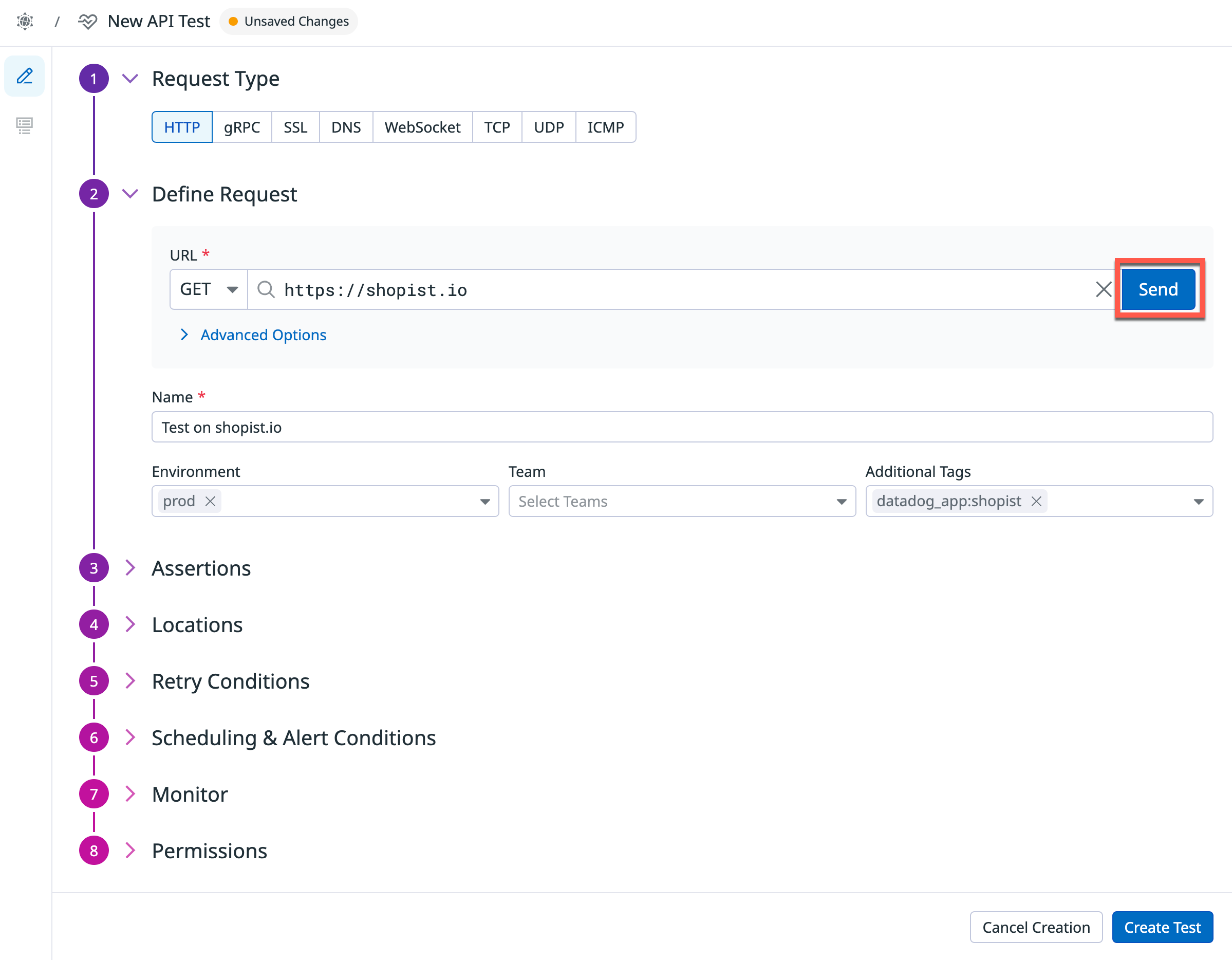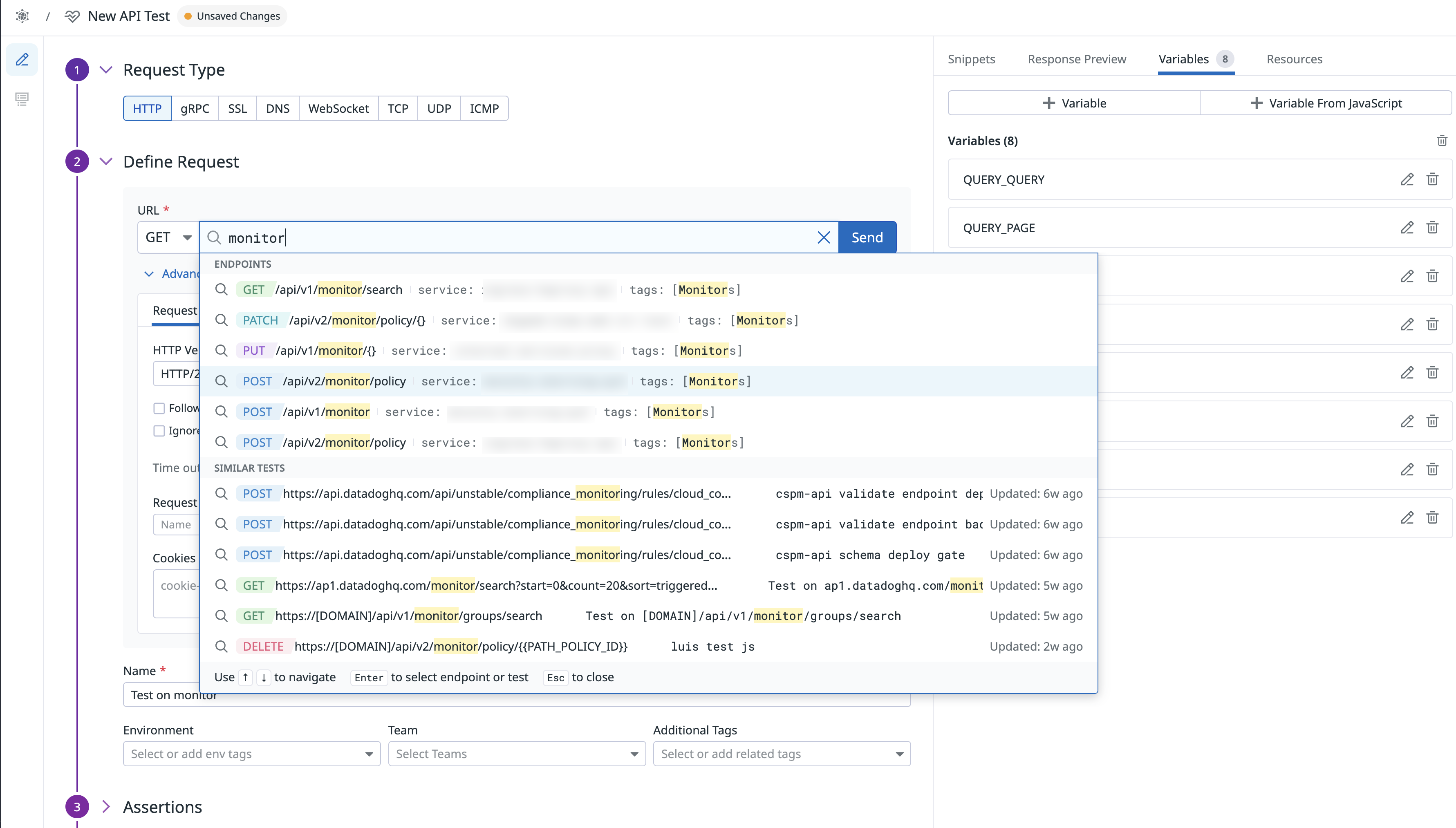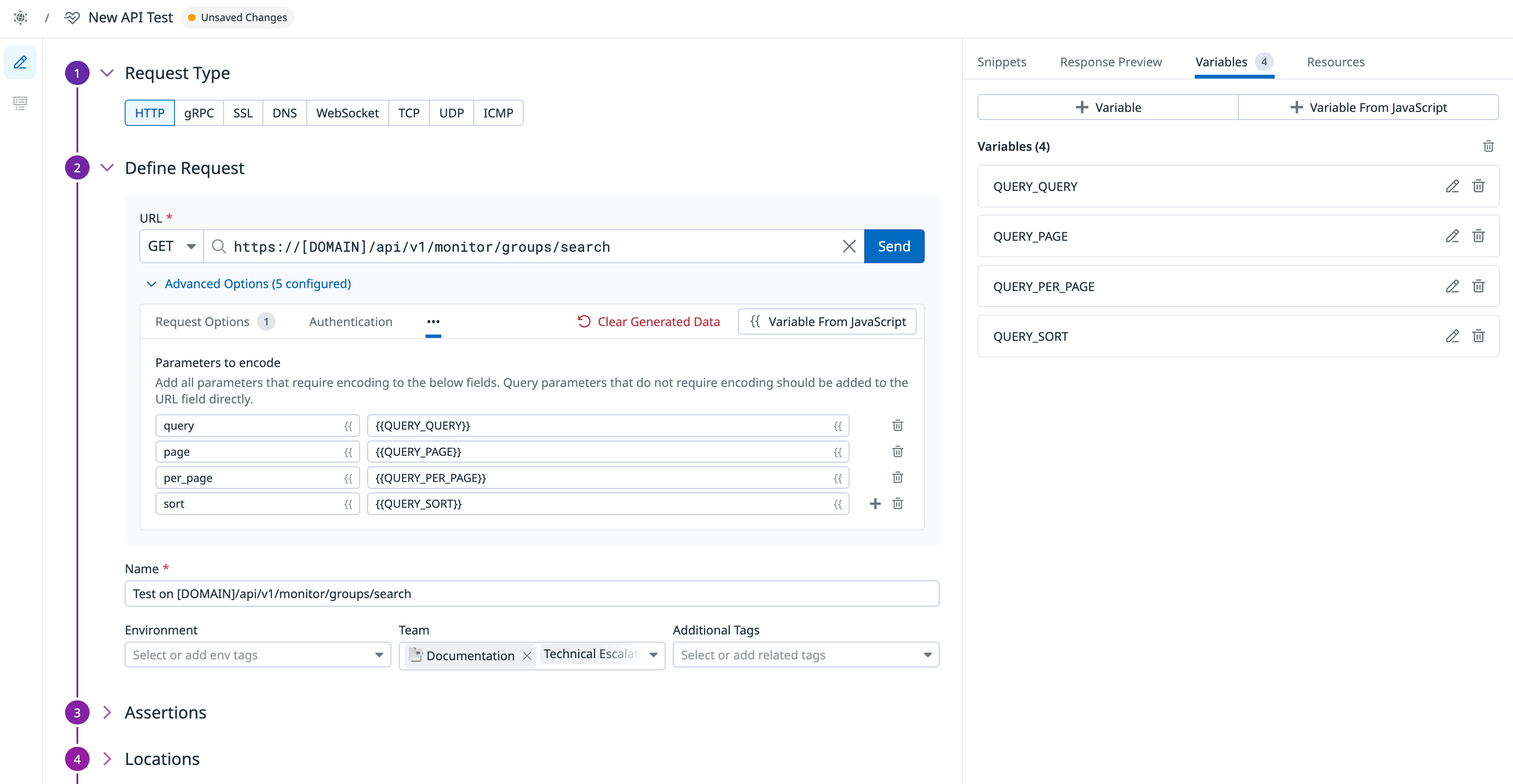- 重要な情報
- はじめに
- 用語集
- Standard Attributes
- ガイド
- インテグレーション
- エージェント
- OpenTelemetry
- 開発者
- Administrator's Guide
- API
- Partners
- DDSQL Reference
- モバイルアプリケーション
- CoScreen
- CoTerm
- Remote Configuration
- Cloudcraft
- アプリ内
- ダッシュボード
- ノートブック
- DDSQL Editor
- Reference Tables
- Sheets
- Watchdog
- アラート設定
- メトリクス
- Bits AI
- Internal Developer Portal
- Error Tracking
- Change Tracking
- Service Management
- Actions & Remediations
- インフラストラクチャー
- Cloudcraft
- Resource Catalog
- ユニバーサル サービス モニタリング
- Hosts
- コンテナ
- Processes
- サーバーレス
- ネットワークモニタリング
- Cloud Cost
- アプリケーションパフォーマンス
- APM
- Continuous Profiler
- データベース モニタリング
- Data Streams Monitoring
- Data Jobs Monitoring
- Data Observability
- Digital Experience
- RUM & セッションリプレイ
- Synthetic モニタリング
- Continuous Testing
- Product Analytics
- Software Delivery
- CI Visibility (CI/CDの可視化)
- CD Visibility
- Deployment Gates
- Test Visibility
- Code Coverage
- Quality Gates
- DORA Metrics
- Feature Flags
- セキュリティ
- セキュリティの概要
- Cloud SIEM
- Code Security
- クラウド セキュリティ マネジメント
- Application Security Management
- Workload Protection
- Sensitive Data Scanner
- AI Observability
- ログ管理
- Observability Pipelines(観測データの制御)
- ログ管理
- CloudPrem
- 管理
HTTP テスト
概要
HTTP テストでは、アプリケーションの API エンドポイントに HTTP リクエストを送信し、応答時間、ステータスコード、ヘッダー、本文のコンテンツなど、定義された条件と応答を確認することができます。
HTTP テストは、ネットワークの外部または内部からのテストの実行の好みに応じて、管理ロケーションとプライベートロケーションの両方から実行することができます。HTTP テストは、スケジュール、オンデマンド、または CI/CD パイプライン内で直接実行することができます。
構成
You may create a test using one of the following options:
Create a test from a template:
あらかじめ用意されたテンプレートの上にマウスカーソルを置き、View Template をクリックします。すると、「Test Details」「Request Details」「Assertions」「Alert Conditions」「Monitor Settings」など、あらかじめ設定された構成情報が表示されるサイドパネルが開きます。
Click +Create Test to open the Define Request page, where you can review and edit the pre-populated configuration options. The fields presented are identical to those available when creating a test from scratch.
Save Details をクリックして、API テストを送信します。
Build a test from scratch:
テストを一から作成するには、+ Start from scratch テンプレートをクリックし、
HTTPリクエストタイプを選択し、クエリする URL を指定します。 使用可能なメソッドは、GET、POST、PATCH、PUT、HEAD、DELETE、OPTIONSです。httpとhttpsの両方の URL がサポートされています。その他のオプションについては、高度なオプションをご覧ください。HTTP テストに名前を付けます。
HTTP テストに Environment タグとその他のタグを追加します。次に、これらのタグを使用して、Synthetic Monitoring & Continuous Testing ページで Synthetic テストをフィルタリングできます。
Send をクリックして、リクエストの構成をテストします。画面の右側に応答プレビューが表示されます。
- Click Create Test to submit your API test.
スニペット
When setting up a new Synthetic Monitoring API test, use snippets to automatically fill in basic auth, performance, and regions, rather than selecting these options manually. The following snippets are available:
Basic Auth: Automatically test your APIs using pre-populated basic auth headers, JavaScript, bearer token, and API/app key auth variables.
Performance: Automatically configure a test with the shortest frequency (one minute), perform a gRPC health check, and test for overall response time latency with a breakdown of network timing.
Regions: Automatically test your API endpoint against a location in each of the three primary geographic regions (AMER, APAC and EMEA).
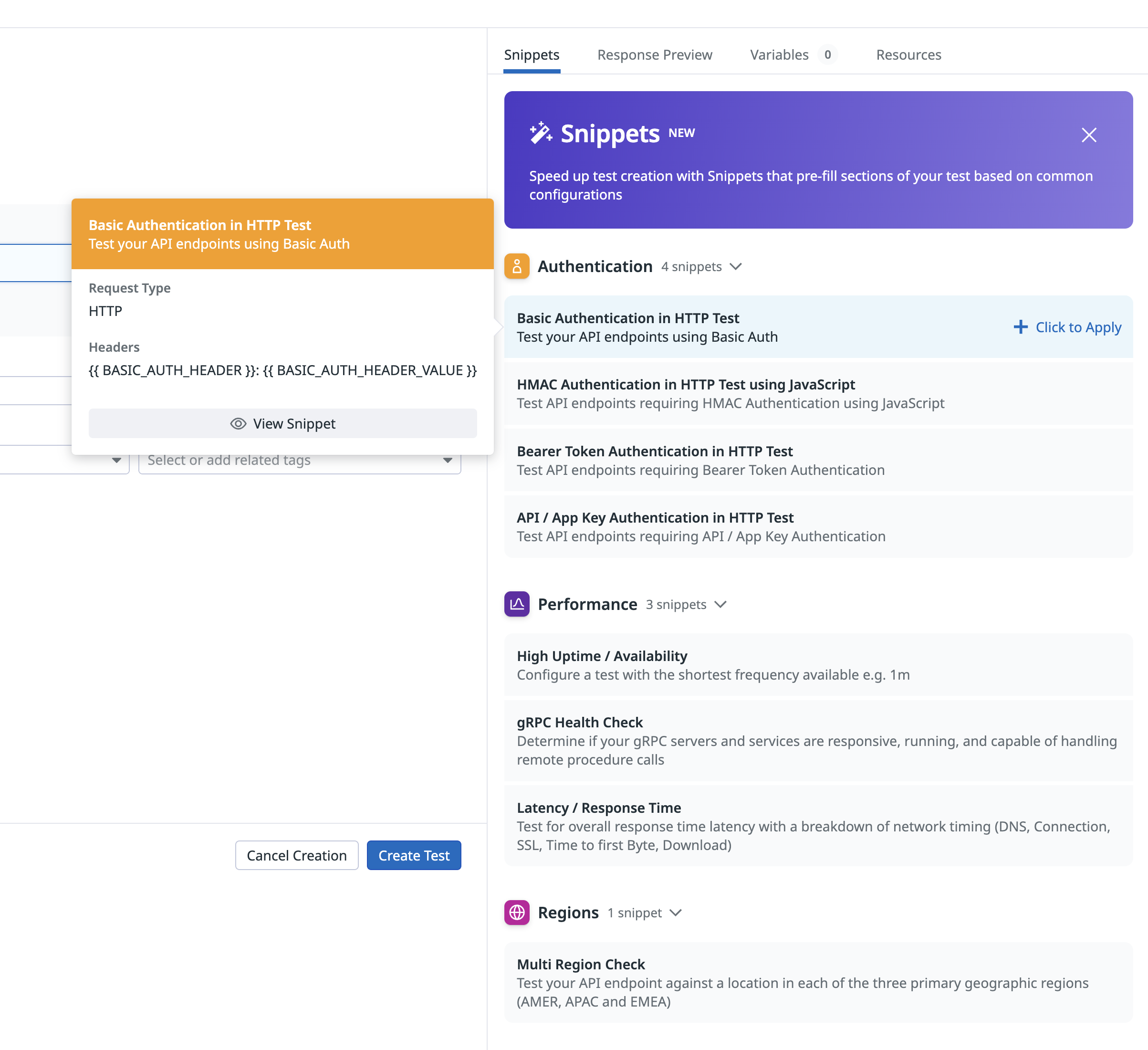
高度なオプション
- HTTP バージョン:
HTTP/1.1 のみ、HTTP/2 のみ、またはHTTP/2 から HTTP/1.1 へのフォールバックを選択してください。 - Follow redirects: 選択すると、リクエストを実行するときに HTTP テストで最大 10 個のリダイレクトをフォローします。
- Ignore server certificate error: 選択すると、SSL 証明書の検証時にエラーが発生した場合でも、HTTP テストが接続を続行します。
- Timeout: テストがタイムアウトするまでの時間を秒単位で指定します。
- Request headers: HTTP リクエストに追加するヘッダーを定義します。デフォルトのヘッダー (たとえば、
user-agentヘッダー) をオーバーライドすることもできます。 - Cookies: HTTP リクエストに追加するクッキーを定義します。
<COOKIE_NAME1>=<COOKIE_VALUE1>; <COOKIE_NAME2>=<COOKIE_VALUE2>の形式を使用して複数のクッキーを設定します。
クライアント証明書: クライアント証明書 (
.crt) と関連する秘密キー (.key) をPEM形式でアップロードして、mTLS を介して認証します。opensslライブラリを使用して証明書を変換することができます。たとえば、PKCS12証明書をPEM形式の秘密キーと証明書に変換します。openssl pkcs12 -in <CERT>.p12 -out <CERT_KEY>.key -nodes -nocerts openssl pkcs12 -in <CERT>.p12 -out <CERT>.cert -nokeysHTTP Basic Auth: HTTP 基本認証資格情報を追加します。
Digest Auth: ダイジェスト認証の資格情報を追加します。
NTLM: NTLM 認証の資格情報を追加します。NTLMv2 と NTLMv1 の両方をサポートします。
AWS Signature v4: Access Key ID と Secret Access Key を入力します。Datadog は、リクエストの署名を生成します。このオプションは、SigV4 の基本的な実装を使用します。Amazon S3 などの特定の署名はそのままではサポートされていません。 Amazon S3 バケットへの “Single Chunk” 転送リクエストの場合、リクエストの本文を sha256 エンコードした値を含む
x-amz-content-sha256ヘッダーを追加します (本文が空の場合は、x-amz-content-sha256: e3b0c44298fc1c149afbf4c8996fb92427ae41e4649b934ca495991b7852b855を使用します)。OAuth 2.0: クライアント資格情報またはリソース所有者のパスワードのどちらかを付与するかを選択し、アクセストークンの URL を入力します。選択内容に応じて、クライアント ID とシークレット、またはユーザー名とパスワードを入力します。ドロップダウンメニューから、API トークンを基本認証ヘッダーとして送信するか、クライアント資格情報を本文に送信するかを選択します。オプションで、オーディエンス、リソース、スコープなどの追加情報を提供できます (Resource Owner Password を選択した場合は、クライアント ID とシークレットも提供します)。
- Encode parameters: エンコーディングが必要なクエリパラメーターの名前と値を追加します。
- Body type: HTTP リクエストに追加するリクエスト本文のタイプ (
application/json、application/octet-stream、application/x-www-form-urlencoded、multipart/form-data、text/html、text/plain、text/xml、GraphQL、またはNone) を選択します。 - Request body: HTTP リクエスト本文の内容を追加します。
application/json、application/x-www-form-urlencoded、text/html、text/plain、text/xml、GraphQLでは、リクエスト本文のサイズは最大 50 キロバイトに制限されます。application/octet-streamでは、リクエスト本文は 3 メガバイトのファイル 1 つに制限されます。multipart/form-dataでは、リクエスト本文はそれぞれ 3 メガバイトのファイル 3 つに制限されます。
- Proxy URL: HTTP リクエストが通過する必要があるプロキシの URL (
http://<YOUR_USER>:<YOUR_PWD>@<YOUR_IP>:<YOUR_PORT>) を指定します。 - Proxy header: プロキシへの HTTP リクエストに含めるヘッダーを追加します。
- Do not save response body: 応答の本文が実行時に保存されないようにするには、このオプションを選択します。テスト結果に機密データを含めたくない場合に有用です。障害発生時のトラブルシューティングに影響を及ぼす可能性があるため、慎重に使用してください。セキュリティに関する推奨の詳細は、Synthetic Monitoring Security をご確認ください。
JavaScript を使用して HTTP API テスト用の変数を定義します。
アサーションを定義する
アサーションは、期待されるテスト結果が何であるかを定義します。Test URL をクリックすると、response time、status code、header、content-type の基本的なアサーションが、取得された応答に基づいて追加されます。テストで監視するには、少なくとも 1 つのアサーションを定義する必要があります。
| タイプ | 演算子 | 値の型 |
|---|---|---|
| 本文 | contains、does not contain、is、is not、matches、does not match、jsonpath、xpath | 文字列 正規表現 |
| ヘッダー | contains、does not contain、is、is not、matches、does not match | 文字列 正規表現 |
| response time | is less than | 整数 (ms) |
| ステータスコード | is、is not、matches、does not match | 整数 正規表現 |
HTTP テストでは、br、deflate、gzip、identity の content-encoding ヘッダーを使用して本文を解凍することが可能です。
New Assertion をクリックするか、応答プレビューを直接クリックすることで、API テストごとに最大 20 個のアサーションを作成できます。
アサーションで OR ロジックを実行するには、matches regex コンパレータを使って (200|302) のように複数の期待値を持つ正規表現を定義します。たとえば、サーバーが 200 あるいは 302 というステータスコードで応答したときに HTTP テストを成功させたいことがあるでしょう。ステータスコードが 200 あるいは 302 であれば、 status code アサーションは成功します。body や header アサーションに OR ロジックを追加することもできます。
テストがレスポンス本文にアサーションを含まない場合、本文のペイロードはドロップし、Synthetics Worker で設定されたタイムアウト制限内でリクエストに関連するレスポンスタイムを返します。
テストがレスポンス本文に対するアサーションを含み、タイムアウトの制限に達した場合、Assertions on the body/response cannot be run beyond this limit というエラーが表示されます。
ロケーションを選択する
HTTP テストを実行するロケーションを選択します。HTTP テストは、ネットワークの外部または内部のどちらからテストを実行するかの好みによって、管理ロケーションとプライベートロケーションの両方から実行できます。
Datadog’s out-of-the-box managed locations allow you to test public-facing websites and endpoints from regions where your customers are located.
AWS:
| Americas | Asia Pacific | EMEA |
|---|---|---|
| Canada Central | Hong Kong | Bahrain |
| Northern California | Jakarta | Cape Town |
| Northern Virginia | Mumbai | Frankfurt |
| Ohio | Osaka | Ireland |
| Oregon | Seoul | London |
| São Paulo | Singapore | Milan |
| Sydney | Paris | |
| Tokyo | Stockholm |
GCP:
| Americas | Asia Pacific | EMEA |
|---|---|---|
| Dallas | Tokyo | Frankfurt |
| Los Angeles | ||
| Oregon | ||
| Virginia |
Azure:
| Region | Location |
|---|---|
| Americas | Virginia |
The Datadog for Government site (US1-FED) uses the following managed location:
| Region | Location |
|---|---|
| Americas | US-West |
テストの頻度を指定する
HTTP テストは次の頻度で実行できます。
- On a schedule: 最も重要なエンドポイントにユーザーが常にアクセスできるようにします。Datadog で HTTP テストを実行する頻度を選択します。
- Within your CI/CD pipelines: 欠陥のあるコードがカスタマーエクスペリエンスに影響を与える可能性があることを恐れずに出荷を開始します。
- On-demand: チームにとって最も意味のあるときにいつでもテストを実行します。
Define alert conditions
Set alert conditions to determine the circumstances under which you want a test to fail and trigger an alert.
Alerting rule
When you set the alert conditions to: An alert is triggered if any assertion fails for X minutes from any n of N locations, an alert is triggered only if these two conditions are true:
- At least one location was in failure (at least one assertion failed) during the last X minutes;
- At one moment during the last X minutes, at least n locations were in failure.
Fast retry
Your test can trigger retries X times after Y ms in case of a failed test result. Customize the retry interval to suit your alerting sensibility.
Location uptime is computed on a per-evaluation basis (whether the last test result before evaluation was up or down). The total uptime is computed based on the configured alert conditions. Notifications sent are based on the total uptime.
Configure the test monitor
A notification is sent by your test based on the alerting conditions previously defined. Use this section to define how and what to message your team.
Similar to how you configure monitors, select users and/or services that should receive notifications either by adding an
@notificationto the message or by searching for team members and connected integrations with the dropdown menu.Enter the notification message for your test or use pre-filled monitor messages. This field allows standard Markdown formatting and supports the following conditional variables:
| Conditional Variable | Description |
|---|---|
{{#is_alert}} | Show when the test alerts. |
{{^is_alert}} | Show unless the test alerts. |
{{#is_recovery}} | Show when the test recovers from alert. |
{{^is_recovery}} | Show unless the test recovers from alert. |
{{#is_renotify}} | Show when the monitor renotifies. |
{{^is_renotify}} | Show unless the monitor renotifies. |
{{#is_priority}} | Show when the monitor matches priority (P1 to P5). |
{{^is_priority}} | Show unless the monitor matches priority (P1 to P5). |
Notification messages include the message defined in this section and information about the failing locations. Pre-filled monitor messages are included in the message body section:
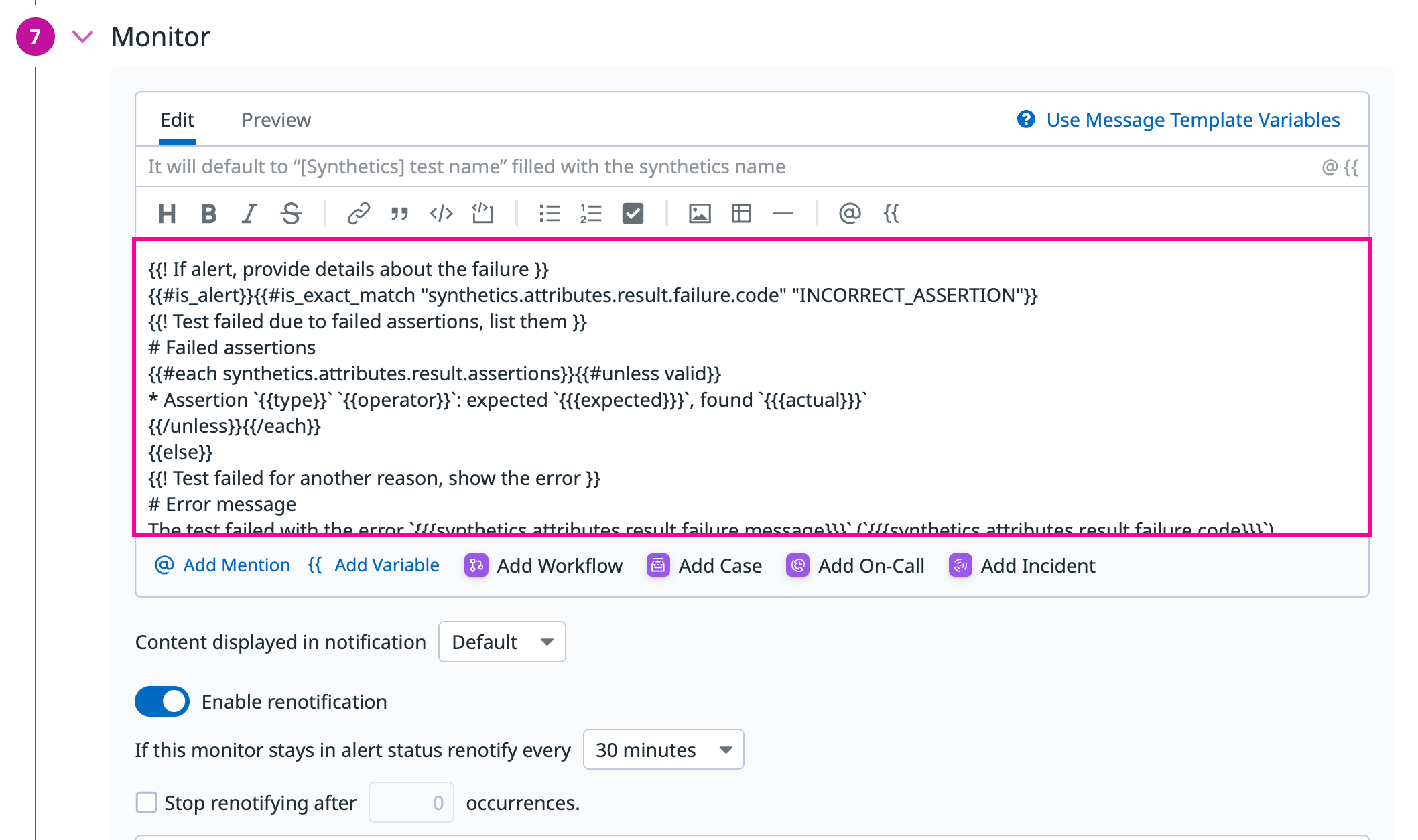
Specify how often you want your test to re-send the notification message in case of test failure. To prevent renotification on failing tests, check the option
Stop re-notifying on X occurrences.Click Save & Start Recording to save your test configuration and monitor.
For more information, see Synthetic Monitoring notifications.
ワンクリック
API テストの作成は、ソフトウェアカタログと既存の API テストからエンドポイントを提案し、テストフォームに関連するオプションを自動入力します。既存の Datadog データソース (APM トレース、Software Catalog で検出されたエンドポイント、ユーザーが作成した類似の Synthetic テストなど) を活用します。
Synthetic Monitoring の API テスト URL 入力に入力を開始すると、エンドポイントの提案や類似テストを取得できます。
次に、提案を選択してテスト構成 (リクエストオプションとヘッダー、認証、変数) を自動入力します。
Create local variables
To create a local variable, click + All steps > Variables. You can select one of the following available builtins to add to your variable string:
- {{ numeric(n) }}
- Generates a numeric string with
ndigits. - {{ alphabetic(n) }}
- Generates an alphabetic string with
nletters. - {{ alphanumeric(n) }}
- Generates an alphanumeric string with
ncharacters. - {{ date(n unit, format) }}
- Generates a date in one of Datadog’s accepted formats with a value corresponding to the UTC date the test is initiated at + or -
nunits. - {{ timestamp(n, unit) }}
- Generates a timestamp in one of Datadog’s accepted units with a value corresponding to the UTC timestamp the test is initiated at +/-
nunits. - {{ uuid }}
- Generates a version 4 universally unique identifier (UUID).
- {{ public-id }}
- Injects the Public ID of your test.
- {{ result-id }}
- Injects the Result ID of your test run.
To obfuscate local variable values in test results, select Hide and obfuscate variable value. Once you have defined the variable string, click Add Variable.
変数を使用する
HTTP テストの URL、高度なオプション、アサーションで、Settings ページで定義されたグローバル変数を使用することができます。
変数のリストを表示するには、目的のフィールドに {{ と入力します。
テストの失敗
テストが 1 つ以上のアサーションを満たさない場合、またはリクエストが時期尚早に失敗した場合、テストは FAILED と見なされます。場合によっては、エンドポイントに対してアサーションをテストすることなくテストが実際に失敗することがあります。
よくあるエラーは以下の通りです。
AUTHENTICATION_ERROR
:Synthetic Monitoring は認証失敗が発生した場合、自動的にテストのリトライを無効にします。この安全策は、有効な認証情報を使ってテストを更新するまで継続されます。これにより、不要なテスト実行が行われ、誤アラートが発生したり課金対象の使用量が増加したりすることを防ぎます。
CONNREFUSED- ターゲットマシーンが積極的に拒否したため、接続できませんでした。
CONNRESET- 接続がリモートサーバーによって突然閉じられました。Web サーバーにエラーが発生した、応答中にシステムが停止した、Web サーバーへの接続が失われた、などの原因が考えられます。
DNS- テスト URL に対応する DNS エントリが見つかりませんでした。原因としては、テスト URL の誤構成や DNS エントリの誤構成が考えられます。
Error performing HTTP/2 request- リクエストを実行できませんでした。詳細は専用のエラーページを参照してください。
INVALID_REQUEST- テストのコンフィギュレーションが無効です (URL に入力ミスがあるなど)。
SSL- SSL 接続を実行できませんでした。詳細については、個別のエラーページを参照してください。
TIMEOUT- リクエストを一定時間内に完了できなかったことを示します。
TIMEOUTには 2 種類あります。TIMEOUT: The request couldn't be completed in a reasonable time.は、リクエストの持続時間がテスト定義のタイムアウト (デフォルトは 60 秒に設定されています) に当たったことを示します。 各リクエストについて、ネットワークウォーターフォールに表示されるのは、リクエストの完了したステージのみです。例えば、Total response timeだけが表示されている場合、DNS の解決中にタイムアウトが発生したことになります。TIMEOUT: Overall test execution couldn't be completed in a reasonable time.は、テスト時間 (リクエスト+アサーション) が最大時間 (60.5s) に達したことを示しています。
MALFORMED_RESPONSE- リモートサーバーが HTTP 仕様に準拠していないペイロードで応答しました。
権限
デフォルトでは、Datadog 管理者および Datadog 標準ロールを持つユーザーのみが、Synthetic HTTP テストを作成、編集、削除できます。Synthetic HTTP テストの作成、編集、削除アクセスを取得するには、ユーザーをこれら 2 つのデフォルトのロールのいずれかにアップグレードします。
カスタムロール機能を使用している場合は、synthetics_read および synthetics_write 権限を含むカスタムロールにユーザーを追加します。
アクセス制限
Use granular access control to limit who has access to your test based on roles, teams, or individual users:
- Open the permissions section of the form.
- Click Edit Access.

- Click Restrict Access.
- Select teams, roles, or users.
- Click Add.
- Select the level of access you want to associate with each of them.
- Click Done.
You can view results from a Private Location even without Viewer access to that Private Location.
| Access level | View test configuration | Edit test configuration | View test results | Run test |
|---|---|---|---|---|
| No access | ||||
| Viewer | Yes | Yes | ||
| Editor | Yes | Yes | Yes | Yes |
